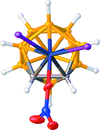issue contents
June 2015 issue

Cover illustration: The crystal structure of a copper(II) complex of 2,6-diacetylpyridine bis(thiosemicarbazone) displays partial conversion of a thioamide group to nitrile. The compound formation is correlated to its potential as a therapeutic tool for Alzheimer's disease and other neurodegenerative diseases. See Vieira, Thompson, Beraldo & Storr [Acta Cryst. (2015), C71, 430-434].
research papers


































 journal menu
journal menu

































